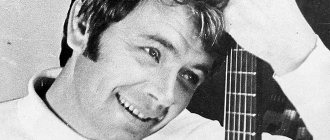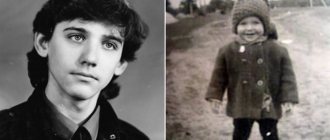Biography of Yuri Aizenshpis
Yuri Shmilevich Aizenshpis is a pioneer of domestic show business, who had an unsurpassed talent for producing and promoting pop stars, winner of the Ovation Award in the Best Producer category.
Russian producer Yuri Aizenshpis
At the age of 24, he went to prison for speculation on an especially large scale, smuggling and conducting illegal currency transactions, subsequently serving 17 years. Having been freed, he brought Kino, led by Viktor Tsoi, to the all-Union level and made it the main group in the country. After the musician’s death, he was the first to break the state’s monopoly on record production by releasing the band’s last mournful “Black Album.”
He was called the “godfather”, “show business shark”, “Karabas-Barabas of Russian pop music” for the win-win result of cooperation with him by artists who became mega-popular, but were obliged to obey him unquestioningly and give the main income from performances (at the initial stage - 90% , at the final stage – 60%). Among his wards were: the rock group “Technology”, “Dynamite”, singers Vlad Stashevsky, Linda, Katya Lel, Dima Bilan.
Producer Yuri Aizenshpis
Yuri Aizenshpis decided to take music seriously. Initially, the recidivist was sheltered by the creative association “Gallery”, which worked under the wing of the city committee of the Komsomol. Yuri Aizenshpis has always been distinguished by his high sociability and incredible ability to adapt in any conditions. This helped him in his work. Ideological Komsomol members felt the taste of money and were not averse to making extra money on young talents. Aizenshpis quickly got up to speed in the music business and soon abandoned patronage, starting to work for himself.
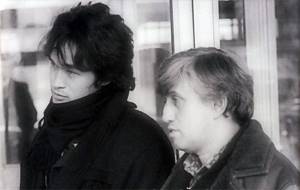
Yuri Aizenshpis and Viktor Tsoi
His first production project was the Kino group and its leader Viktor Tsoi. It was then that he first called himself a producer. In 1990, Yuri Aizenshpis was the first in the USSR to fully finance the release of the “Black Album” of the Kino group with his own funds. Before him, no one had risked doing this. After Tsoi, he worked with the rock groups “Technology”, “Moral Code” and “Dynamite”. Following the groups came the turn of solo performers - Vlad Stashevsky, Katya Lel, Dima Bilan and several others of a smaller caliber.
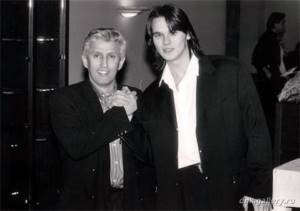
Yuri Aizenshpis and Vlad Stashevsky
To finance Stashevsky’s project, Aizenshpis recruited the crime boss Alexander Makushenko, who was well known to him from years of imprisonment, whom he knew as Sasha Gypsy. Music in the hands of a businessman turned out to be an attractive tool for making big money. In 2001, Aizenshpis became the general director of the entire Media Star enterprise. Everything would have been fine, but I was very worried about my health. Yuri Aizenshpis was forced to adhere to a constant diet, regularly see doctors and constantly swallow a bunch of pills.
Childhood and youth
The future professional, capable of creating bright and magnificent projects even from mediocre performers, was born on July 15, 1945 in Chelyabinsk. During the Second World War, his pregnant mother, Maria Mikhailovna, a native of Belarus, a participant in the partisan movement in the Gomel region, a graduate of the journalism department of Minsk University (though she never received a diploma), ended up there.
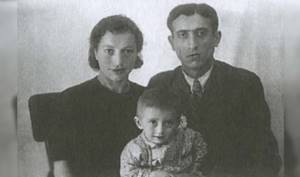
Yuri Aizenshpis with his parents
Father, Shmul Moiseevich, mistakenly recorded in the passport as Shmil, was a hairdresser originally from Poland. He ended up in the USSR fleeing the Nazis, then in the ranks of the Red Army he reached Berlin. Anti-Semitism did not affect Yuri or his family members at all; according to the producer, they did not face any harassment because of their Jewish nationality.
Yuri's parents met in 1944 in Moscow, where their family later moved. For a long time they wandered around the capital's barracks, but, working in the Main Directorate of Airfield Construction, they lived well for those times - they had a TV that cost two average salaries, a gramophone with a solid collection of records. In 1957, their daughter Faina appeared in their family, and in 1961 they received an apartment in the Sokol metro area.
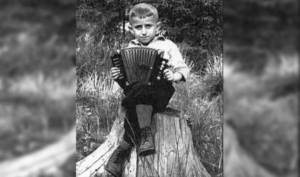
Yuri Aizenshpis in childhood
The boy was a fan of handball, volleyball and the “queen of sports” - athletics. He attended a sports school, where many future champions and prominent sports figures studied with him. In particular, he was friends with Vladimir Aleshin (later general director of the Luzhniki Olympic complex). At the age of 16, due to a leg injury, he had to give up sports.
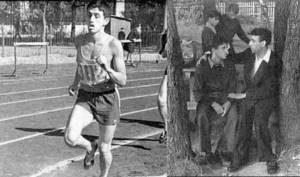
Yuri Aizenshpis in his youth
At that time, he was also fond of jazz and recorded compositions by Louis Armstrong, Ella Fitzgerald, John Coltrane, Woody Herman, and other leading musicians of the world. Later he became interested in rhythm and blues, which stood at the origins of rock and roll.
Family and childhood of Yuri Aizenshpis
Yuri Aizenshpis, whose photo can be seen in this article, was born in Chelyabinsk, immediately after the war, on June fifteenth, 1945. His father Shmil Moiseevich was a veteran of the Great Patriotic War. Mother's name was Maria Mikhailovna. The surname Aizenshpis means “iron peak” in Yiddish. Yuri's parents were Jews and worked in the Main Directorate for Airfield Construction.
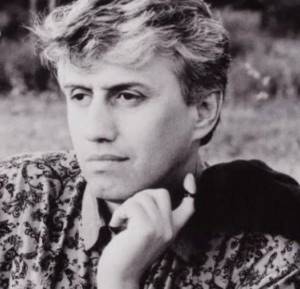
At first the family lived in a wooden barracks. But in 1961 they received an apartment in Sokol (it was a prestigious Moscow district at that time). Yuri Aizenshpis was very fond of sports since childhood. His greatest interests were athletics, handball and volleyball. He could well become a champion in one of these areas. But he still had to leave the sport. The reason for this was a leg injury he received at the age of 16.
The beginning of the way. Jail
Having received a certificate, the young man entered the Economic and Statistical Institute (MESI). While studying in 1965, he simultaneously began producing the rock group Sokol, arranging its semi-underground performances in a local cafe and the House of Culture, and with a job at the Tula Philharmonic and receiving official status, tours around the Union. Even then, he showed his natural business acumen - his monthly income reached more than 1.5 thousand rubles.
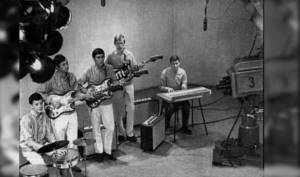
The group "Falcon", with which the career of Yuri Aizenshpis began
In 1968, Aizenshpis received a diploma as an engineer-economist and, after leaving the Philharmonic, began working at the Central Statistical Office with a salary of 115 rubles. At the same time, he was engaged in activities that today are called entrepreneurship, but were then considered illegal.
For example, Yuri bought tickets for his band’s concerts at the state price and sold them at a speculative price. Then he began to purchase currency for the purchase of scarce goods, and later - gold bullion in the commercial branch of Vneshtorgbank, and sold them several times more expensive. As a result of such fraud, he soon became a millionaire, and in 1970 he was sent to prison for 10 years.
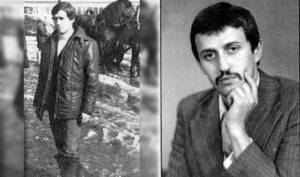
Yuri Aizenshpis during his imprisonment
In 1977, Yuri was released on parole, but, having returned to his old ways, after 3 months he again found himself behind bars. Although it should be noted that thanks to his phenomenal communication skills and entrepreneurial talent, Eisenspitz was able to make his stay in the zone quite bearable. He was finally released from prison in 1987 and later received a not guilty verdict on all counts.
Yuri Aizenshpis: biography. Arrest
Using the proceeds from ticket sales (mostly dollars), Aizenshpis purchased musical instruments for the group and high-quality sound equipment from foreigners. But at that time in the USSR all foreign exchange transactions were illegal, and he took a great risk by making such transactions. If he had been caught, he could have been imprisoned for a serious prison term.
Law enforcement agencies drew attention to his “speculative” activities. On January 7, 1970, Aizenshpis was arrested. During the search, more than 7 thousand dollars were found and confiscated (as Yuri himself admitted in one of his interviews, he had even accumulated more than 17 thousand dollars) and over 15,000 rubles. Aizenshpis Yuri Shmilevich was convicted of currency fraud. He was given a sentence of ten years in prison. Yuri was sent to the city of Krasnoyarsk to serve his sentence.
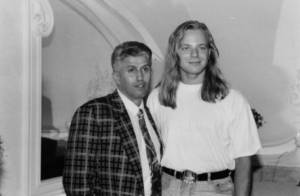
After he was released, he did not enjoy it for long. And again he ended up in prison under the same article. But this time he was given seven years and eight months in prison. In total, he served seventeen years in prison. And he was finally released only in April 1988.
Show business career
Upon release, Yuri fell into a deep depression and suffered a heart attack - at 42 he had nothing: no apartment, no family, no money.
He began organizing performances for aspiring performers, working in the creative youth association “Gallery” under the city committee of the Komsomol. Over time, his friend musician and director Alexander Lipnitsky, stepson of V.M. Sukhodrev, a personal translator for the country's top leaders (including Brezhnev, Khrushchev, Gromyko, Gorbachev), helped him get the position of director of the Interchance festival. Initially, he began collaborating with the Kino group, which recorded the album Blood Type. He brought the team to the big stage, organized participation in the popular television programs “Vzglyad” and “Morning Mail”, which the whole country watched in those years, involved the press and turned Tsoi into a superstar. After the tragic death of the singer in 1990, taking out a loan of 5 million, Eisenspitz released his posthumous disc and as a result earned authority and 24 million rubles.
Yuri Aizenshpis about Viktor Tsoi and working with the Kino group In 1991, having taken up his second project - the Tekhnologiya group, the producer showed that even performers of average talent can be made into stars. A year later, he received the Ovation Award as the country's best producer and began producing the Moral Code and Young Guns groups. In 1993, he worked on the promotion of singer Linda, who later worked under the supervision of composer Maxim Fadeev.

Yuri Aizenshpis on the set with the group "Technology"
Then, for six years, Eizenshpitz collaborated with Vlad Stashevsky. Each of the musician's five albums released during this period became a bestseller. The artist was invited to all major events in the country, and in 1997, at the invitation of the US Senate, he performed in front of an audience of 20 thousand in Brooklyn Park.

Yuri Aizenshpis and Vlad Stashevsky
In 1995, the producer was again awarded the Ovation Prize for his creative achievements, and in 1997, his track record included such stars as Katya Lel, Inga Drozdova, then singer Nikita, Sasha, and the Dynamite group. In 2001, Yuri took the post of general director of the largest production company Media Star. In addition, he showed himself as a writer, presenting the autobiographical book “Lighting the Stars.”

Yuri Aizenshpis with the Dynamite group
The last and main project of Yuri Shmilevich was Dima Bilan. Unlike Stashevsky, Aizenshpitz called him “a real talent” and not a “synthetic product.” Yuri did not live literally two days before the triumph of his pupil, who received the MTV RMA-2005 award in the categories “Best Performer” and “Best Artist”. Dmitry went on stage to receive the award along with Misha, the producer’s 8-year-old son, and the audience observed a minute of silence in memory of Yuri.

Yuri Aizenshpis and Dima Bilan
Did Aizenshpis bring the “blue lobby” into show business?
In the last weekly, we started a story about the most controversial producer of domestic show business - Yuri Aizenshpis. From the biography of Yuri Shmilevich it is clear that in many ways he, without fear of anything, even prison, went ahead to earn money, which he then invested in show business. And, as those who worked with him assure, the current face of our stage - with all the pros and cons - is in many ways the same as Aizenshpis saw him in his time. Today we continue our story about him. About the tough character - Yuri Shmilevich tried to control our every step, he had many “ears and informants” in one of his pets, singer Nikita. “He tried to get involved in literally everything, even advised which girl I should be friends with. The one I had seemed unsuitable to him, so he matched me with another. But once I made it clear to him that I would not tolerate such excessive control, he was offended. He wanted to be friends, to be closer, but I, a reserved person, was passionate about music. He usually gave everyone advice on which parties to go to and which not to. I didn’t go to parties at all, but sat in the studio and wrote songs for myself. He and I often had clashes. He just screamed at me. But I also showed my teeth. One day he insisted that I sing a song that I didn't like. It came to a conflict. Finally I was convinced to make concessions to him. And I... recorded a song with a Georgian accent. Yuri Shmilevich sat down to listen to the recording and shouted: “It’s not Nikita singing, it’s some Georgian?!” For several more minutes the walls of the studio were shaken by his screams. In his book, Yuri Shmilevich wrote that I was jealous of him for Bilan. No, I wasn't jealous. Although I didn’t understand why he was making the second Nikita out of the new Bilan. Everything that was worked out on me, he rolled out as a carbon copy in the promotion of Bilan. Apparently, he wanted to quickly return the money and make money. Shmilevich really counted on me, but I bucked up - I wanted to write electronic music, but he insisted that I remain in a pop image. As a result, Shpis decided to let me go. By this point, he began to even more actively promote Bilan, who did not argue with him. Although Dima required large financial investments. I wrote my own songs, and I didn’t get paid for it. - They say that Aizenshpis took revenge on you, cut off oxygen? - I heard such conversations... But I had no other way - I didn’t see any development with Aizenshpis... — I wrote songs for Aizenshpis’s wards. It must be admitted that Aizenshpis was incredibly demanding of his subordinates. He himself caught fire with the idea and demanded the same “spark” from everyone around him,” says “dynamite” Ilya Zudin. — One day I brought a disc with a new recording, but the disc wouldn’t turn on. Aizenshpis decided that I simply didn’t do the work and was trying to blame everything on the equipment. He yelled at me without choosing words. I heard such insults that I could not stand it - I slammed the door and promised to break off all contacts with this person. However, after a while he called: “Well, I got excited. Let’s come and make peace!” It turned out that the disk miraculously worked, and Yuri was convinced that I had not deceived him... He was tyrannical. Before my eyes, he threw various objects at people. Most often it hit the head. People left with bruises. But they endured - becoming an enemy of Aizenshpis, you know, is more expensive for yourself! He could make trouble for those who wanted to cross his path. But he was quick-witted... On tour in Jurmala, Aizenshpis broke the camera of a photographer who was taking “spy pictures”. The fragments hit the face of the photojournalist, who wrote a statement to the police. We “made our feet” from this “Jurmala”, fearing that Aizenshpis would be imprisoned. He could be cruel. But at critical moments he acted according to concepts. When my father died, he opened his bag, took out, without looking, an armful of dollars and handed it to me: “Bury your father with dignity.” Then I never thought about this money and did not reproach it...
“Blue Lobby” The name of Yu. A. is associated with the appearance of the “blue lobby” in showbiz. Allegedly, at first the cool guys brought their mistresses to the producer to promote their mistresses, and then they started bringing... lovers. — For some reason, in recent years, Yura began to promote some slender boys for some reasons of his own. He chose cute boys with sexy characteristics, as he imagined,” Artemy Troitsky told KP. “I did not support him in this direction and told him about it, he was upset. Partly because of this, we almost stopped communicating with him. They often argued, even over Bilan... I heard rumors about “Shpis”’s unconventional orientation. But I can’t blame him for anything specific. He had a wife and son. I don’t know why they got divorced. When for some reason he dyed his noble gray hair blue-black, it seemed wild to me... “My fellow dancers were afraid of Aizenshpis,” producer Vitaly Manshin told KP. “I noticed that Aizenshpis reacted calmly to girls, but with the boy dancers he quickly found a common language. I still couldn’t find him a backup dancer for Dima Bilan. Sent two girls. He rejected them. I offered him the guys from the Mirage ballet. Aizenshpis liked them. He went on tour with them and Bilan, and upon returning the guys rushed to me with wide-eyed eyes: “No, we won’t work with Aizenshpis!” Then I agreed with three guys from the “Dance Master” ballet (one of them was an ex-member of “Reflex” Denis). The guys somehow hesitated and asked me about Aizenshpis: “Won’t he pester us?” But the guys with normal orientation work with him! However, after a few days of working with Yuri, Denis came running back to me: “No, I can’t do that.” Apparently, something was happening there... He lured away the dance group from me, apparently managing to win over one dancer-leader. —Are you hinting at Aizenshpis’s own unconventional orientation? - I didn’t tell you this! You know, I still want to live. I don’t want them to come and shoot me in the head. - So he died?! - His friends remain. Therefore, I will not speak badly about him... - Spending time in prison could have influenced Aizenshpis's orientation. If all other producers in those years promoted exclusively mistresses, wives, girls (if a boy singer appeared, then most often he turned out to be the son of some producer), then Aizenshpis was drawn to promote guys. Many people talked about his “blue lobby”. Nowadays this will surprise few people. I know that he did wrong concerts and received good money from cool people for inviting stars to them,” Alexander Stefanovich, Alla Pugacheva’s ex-husband and promoter, told KP.
Alexander Tolmatsky: “The leadership was taken away from Aizenshpis by Krutoy” - I call Aizenshpis the best producer. He worked all his life. He started with me in the 70s,” Yuri Shmilevich’s former friend Alexander Tolmatsky, producer of Decl, Oleg Gazmanov, and the “Combination” group, told KP. — Since the late 70s, Yura Aizenshpis and I were among the first to engage in underground concerts, trading (then speculation) in musical instruments and records. Yura, in addition to this, also took up currency trading, for which he sat down. We also ran discos. He and I are one of those who stood at the origins of Russian show business. Everything else is a new generation that appeared in the 90s. Until 2000, Aizenshpis and I were leaders in the music market. Aizenshpis worked as a director in mine, and among my founding partners was the then director of the Muz TV channel, who quietly sold the channel to Igor Krutoy, after which my company lost its leadership position, and Igor Krutoy gained influence in the music market. Compared to him, Pugacheva was more likely an organizer rather than a producer. And Kobzon is not a producer, but an artist. — They say Aizenshpis communicated with crime bosses? — You know, all the “authorities” in different fields communicate with each other, it’s just the way it is. Aizenshpis was respected by everyone. He never did anything in secret. He was a very decent man. — Is it true that Aizenshpis brought the “blue lobby” into show business? — There is such an opinion (chuckling). He was often surrounded by boys. I will not comment on this point. But he knew a lot about promoting singers! At the end of his life, Aizenshpis was very worried about Dima Bilan, who became friends with Yana Rudkovskaya. Yura came to visit me and talked about his experiences, he was afraid that Dima would be taken away from him. Those experiences affected Yura’s deteriorating health. Many of his wards were not very grateful. But when they left him, everything went dark. CHAPTERS FROM THE BOOK The Temptation of Dima Bilan * * * The singer wrote about his relationship with Aizenshpis in a book that will be published in the fall. A fragment from it was provided to KP by Dima Bilan’s PR manager. “During the filming of the video “I want to become an oligarch,” we met two respected people - one is very famous in the business community, the other in the world of show business. Yuri Shmilevich and I received a very tempting offer - namely, to “buy” my contract and about my transfer from StarPro to another production company. The situation was made more acute by the fact that another producer offered a very large sum of money, which doubled all of Yuri Shmilevich’s expenses for my promotion. For me, absolutely fabulous horizons opened up - the prospect of working with the best Western composers and musicians, and therefore becoming both a more popular and wealthier person.
- What do you say? — Yuri Shmilevich asked me, after listening to the details of the transaction from the other party. - And you? — I asked him a counter question. “This is a very generous offer,” Yuri Shmilevich praised. “You need to think it over.” Carefully and with a cool head. I took time to think... ...Businessmen ordered me a very expensive car in St. Petersburg, which I could not even dream of at that time. They drove it and placed it right under the window of my rented apartment - at that time I lived on Sokol in a rather modest two-room apartment. In the morning I looked down, saw the beauty sparkling with bumpers and realized that all this could become mine as soon as I signed the necessary papers... - Yuri Shmilevich! — I called one fine day. —Are you sure that you must accept this offer? “Let’s meet and talk,” Aizenshpis immediately responded... ...We met in one of the cafes, each took a cup of coffee and sat silently for a while. “You understand one thing, Dim,” Yuri Shmilevich began to explain. “I cannot offer you the same conditions as these people.” And for us to reach the same level that you can have with them now, it will take us several years... - But we can, right? — I looked up at my mentor. Yuri Shmilevich was silent. He... was ready to agree with any decision I made. - I don’t want to leave you! - I said. — I feel very comfortable, positive, and easy to work with you. We have been together for a long time, and a lot has happened, but I don’t know these people at all. I am confident that they will fulfill absolutely all their promises to the end. But I’m not sure that I can work with them... I looked at Yuri Shmilevich, and it seemed to me that joy flashed in his eyes. The prickly gaze softened, the face brightened and even somehow became younger... “Okay,” he answered briefly. - Thank you for your friendship. * * * For the first couple of years, Yuri Shmilevich and I—or rather he personally—tested each other’s strength. Aizenshpis constantly provoked me, threw some offensive things at me and at the same time carefully watched how I would react. There were a great many negative situations in dealing with him, since Yuri Shmilevich definitely needed to be pushed to that very boiling point, beyond which a person loses patience and begins to actively protest. This was a kind of “test”. Each of his artists or employees at least once reached the final brink when he decided to quit and declared: “That’s it, I don’t work here anymore!” Some left forever, some eventually returned, but it was in such extreme conditions that the Aizenshpis talent forge existed. Moreover, as it seems to me now, Yuri Shmilevich’s “education program” definitely included this item - testing by scandal. Perhaps this also had some sacred meaning, because endless concerts and multi-day tours really eat up so much energy, emotions and nerves that not everyone can survive such stress. They trained us, that is.
PERSONAL IMPRESSION He either blacklisted journalists or recognized them as his own. I was personally acquainted with Yuri Shmilevich. We felt sympathy for each other and communicated tenderly. Then they often told me about the cool and even cruel character of the producer. He could be very rude to journalists, and would do dirty tricks to those who criticized his charges. I couldn’t help but believe in these stories, but Yuri Shmilevich turned to me “not with thorns, but with leaves”... We met in Sochi at a hotel. I was on a business trip, he was on vacation. In shorts, some unimaginable colorful shirt and a smile from ear to ear, like the Nutcracker, Aizenshpis immediately attracted attention. Moreover, the first impression - shock from his creepy appearance - instantly grew into interest in this man. He knew how to bewitch. He couldn’t sit still; everything around him began to spin and sparkle. He immediately ordered the table to be set for me. He immediately rustled the pages of magazines that had come from somewhere. Aizenshpis quickly explained that he met a fashion designer here and decided to collaborate with him. I have already agreed with a local magazine that will publish a photo of Dima Bilan in the costumes of that designer. “Are you going to write about Dima? Agree, it’s a good hotel, my friend runs it. You say, you want to go to Maxim Galkin’s concert, we’ll do it, the director of the Festival is my friend,” Yuri Shmilevich listened to me in one ear, and pressed his cell phone to the other, communicating with some producer and praising the performance of his singer in Sochi, on which he actually didn’t go to. As he ran, he killed a dozen birds with one stone, trying to introduce everyone, make friends and spin them into one common cause. “The main thing is that it is beneficial and interesting for everyone,” Aizenshpis told me. — Are you saying that our PR manager doesn’t give information? I'll smear them all over the wall! Yes, help yourself! I eat according to the fashionable Volkov diet. The salad is specially prepared for me here. I have diabetes. I lost my health in the zone. But I want to live. I deny myself the pleasure of eating delicious food... Look at the photo of Bilan, isn’t he very sexy?!” I nodded. I didn't argue with him at all. In each of our subsequent conversations, he did not forget to ask me when I would write about Dima Bilan. I jokingly made an excuse: this is a very important matter, and I need to prepare well. And along the way, I asked him for small news from the world of show business. Then I learned that Shpis subjected any publication about Bilan to a thorough analysis, after which it either blacklisted the author or added it to its own. Neither the first nor the second happened to me. And all because I never wrote ANYTHING about Bilan. Perhaps this circumstance allowed Aizenshpis and I to communicate without problems until the end of his life... I called him on his mobile two days before his death. I barely recognized his voice. He wheezed that he was very ill in the hospital. But he immediately said that nothing would break through, not for the first time. “I’ll recover a little and go back into battle, Dima needs to do a tour,” he hissed into the trumpet. “Call the PR manager, they’ll tell you something, tell me, I told you to.” And two days later a message came that he was gone. The official diagnosis is heart. There were rumors - AIDS. There is a version that this is the result of stem cell treatment. He was a pioneer in everything. Aizenshpis explained his success like this: “We can say that show business is an already formed industry, the same industry as car production or iron smelting. Here, too, there is its own technology and its own laws... The show is a spectacle. The word “concert” is not suitable, it is associated with the classical genre, be it a symphony orchestra, Zykina or Magomayev... Show business two or three years ago brought a lot of money. Now the whole society is sick and the area where I work is sick. The amount of money spent on big shows today is not justified by the cost of tickets. Advertisers and sponsors are needed. I believe that the advantage in business belongs to those in whose genes the blood of a business person flows. Real business is for the talented. This is art. I am helped by my ability to work, my taste, which has not yet failed me, and my knowledge of the matter.”
Personal life of Yuri Aizenshpitz
There were rumors in the musical environment about the homosexuality of the producer and some of his charges. However, they did not find confirmation and did not prevent his affair with Elena Lvovna Kovrigina, 22 years younger. In 1993, the couple had a son, Misha.
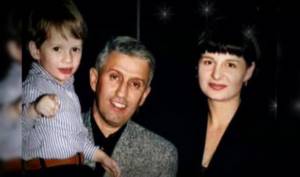
Yuri Aizenshpis with his wife and son
Aizenshpis, a loner by nature, preferred to live in a large separate apartment, although his son, who lived with his mother in a neighboring house, visited him very often. His loving father spared no expense on his education - from an early age the boy learned foreign languages and traveled a lot.

Yuri Aizenshpis and his son
In February 2014, the young man was detained in Moscow on suspicion of drug use. They found a suitcase with money and 1.5 g of cocaine in his possession, but after interrogation, he was released on his own recognizance. In November of the following year, the young man was discovered in the Northern capital. He left home in January and, according to his mother’s statement, was wanted (as someone who had lost contact with relatives).
Yuri Aizenshpis: biography. Childhood and adolescence
Aizenshpis was born in Chelyabinsk in 1945. His mother, Maria Mikhailovna Aizenshpis, a native Muscovite, was sent to evacuate to this city. Shmil Moiseevich Aizenshpis (Yuri's father) is a Polish Jew who was forced to leave his homeland to escape the Nazis. He fought in the ranks of the Soviet army and was a veteran of the Second World War.
After the end of the war, the family returned to Moscow. Until 1961, she lived in a dilapidated wooden barracks, and then received a wonderful apartment in a prestigious area of the capital. At that time they had a gramophone with a large collection of gramophone records and a KVN-49 TV.
As Yuri Shmilevich Aizenshpis himself recalled, in his youth he was seriously involved in sports: handball, athletics, volleyball, but due to a leg injury he had to stop playing. In addition to sports, the young man at that time was interested in jazz. He had a tape recorder, which the young man bought with his savings.
The first recordings were jazz compositions by famous musicians of the world - Woody Herman, John Coltrane, Louis Armstrong, Ella Fitzgerald. Yuri Aizenshpis, whose photo you can see in our article, was well versed in various directions - jazz-rock, avant-garde and popular jazz. After some time, he became interested in the origins of rock music, the founders of the rhythm and blues movement.
The circle of lovers and connoisseurs of this music in those days was very small; everyone knew each other. When one of the like-minded people had a new record, Yuri Aizenshpis rewrote it. At that time, “black markets” were widespread in our country, which the police constantly dispersed. Exchange, purchase and sale were prohibited. The disks were simply confiscated from the sellers. And despite everything, records entered the country from abroad regularly, overcoming the powerful barriers of customs rules and laws. Some performers were banned - Elvis Presley, the Bary sisters.
Death
In 2005, the producer played a minor role in the film “Day Watch,” which received notoriety due to the misfortunes that befell the project participants (in particular, Maria Poroshina sprained her leg, Alexey Maklakov lost his mother and suffered a micro-infarction, Konstantin Khabensky lost his father and subsequently his wife) .
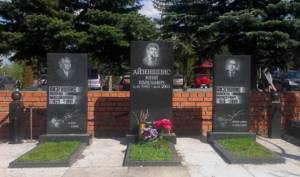
The grave of Yuri Aizenshpis
During filming, Aizenshpis felt unwell. On September 19, he was hospitalized and underwent the necessary medical procedures that improved his condition. However, the next day he died from acute heart failure. In memory of the producer, for whom the main thing in show business was the creative process, and not money, a TV show was broadcast on the TV Center channel as part of the documentary series “Wild Money” (2016-2017). Yuri Aizenshpis. Wild money | Central television
Show business shark
Once free, Aizenshpis found himself in the thick of perestroika. Soon, his friend Alexander Lipnitsky (stepson of Vadim Sukhodrev, Brezhnev’s personal translator) introduced him to the then rock party. At first, he headed the directorate of the Interchance festival, slowly studying the backstage and hidden springs of home-grown show business, and soon began producing domestic musical performers.
Yuri Shmilevich outlined his credo very frankly: “Promoting an artist is the functional responsibility of the producer. And here any means are good. Through diplomacy, bribery, threats or blackmail." This is exactly how he acted, earning the nickname “show business shark.”
His formula for success in show business: “The result is the product of the talent of the performer, the talent of the producer, the time spent by both, the money invested, mutual desire and luck.”
There were many unknown musical performers who dreamed of making it onto the big stage. Aizenshpis looked for those who could hook the viewer, who had at least some more or less attractive repertoire. First, through the media, mainly through television, he promoted them and made them famous, and then organized tours.
Victor Tsoi
After his release from prison in 1988, Yuri got a job in the creative association “Gallery”, created by the city committee of the Komsomol. At first, Aizenshpis organized concerts of young talented performers. In 1989, he became the official producer of the Kino group, after which the group quickly reached a new level of popularity.
At the time of the start of cooperation with Aizenshpis, the Kino group was already quite famous. The most creatively and conceptually successful album, “Blood Type,” had already been recorded and mixed at home, after which, according to critics, Tsoi could not write anything for at least 2 years. Therefore, working with Kino also brought Yuri Shmilevich to a new stellar level of production activity and allowed him to earn authority in his business.
“For the first time after my release, I worked in a creative youth association. Like mushrooms after rain, they began to appear in the fields of all kinds of Komsomol and Soviet organizations. It was a kind of roof. The concept of “manager” had not yet appeared.
One of my first actions was organizing a concert of Leningrad rock bands. They performed then mainly in cultural centers, and I took them to the big stage.
And so I met Viktor Tsoi. In principle, this is not an accident. I found him myself and convinced him to work with me, convinced him that I was not an accidental person in music. He told me what he had experienced. This somehow had an effect on him, although I was a complete stranger to him, and Victor is not the kind of person who makes contact easily.
Our acquaintance turned into friendship. Then the friendship grew into a creative union. I don’t want to attribute unnecessary laurels to myself. Of course, Tsoi and the Kino group were known before our meeting. But they are known among fans of Leningrad basement rock. And I decided to make a rock star out of him. And it was a success. The work was carried out on the radio and in the press. On television, Tsoi appeared for the first time in the “Vzglyad” program, which was then watched by the whole country. The release was made by Mukusev. I convinced him that millions of teenagers need Choi now.
Internally, Tsoi is a very interesting person, unlike anyone else. His second wife greatly influenced him. She is an esthete, from film circles and was a very good friend to him. I think she also did a lot to create the image that is known to the broad masses. He became from the hungry, angry Tsoi, imposing and mysterious. That’s how I recognized him – a mature performer who had already starred in “Assa”. And managed to help him turn into a superstar, or maybe even something more.”
After the tragic death of Tsoi in 1990, Aizenshpis released the last “Black Album” of the Kino group. Moreover, for the first time in post-Soviet history, he does this regardless of the absolute monopolist in the recording market - having taken out a loan of 5 million rubles for this. The posthumous album was released in a circulation of 1,200,000 copies and brought Yuri Shmilevich 24 million rubles.
"Technology" (1991-1992)
The next stage of Aizenshpis’s career was the “Technology” group. And if “Kino” already had a certain initial speed at the start of working with him, then the producer sculpted the success of “Technology” practically “from scratch”, being already an experienced sculptor.
“My second project, Technology, showed that you can take guys of ordinary, average talent and also make stars out of them. I was basically dealing with amateur performances. Among the numerous motley ensembles was the Bioconstructor group, which later split into two subgroups. One was called “Bio”, the other was still just hatching its musical concept. Only two or three songs could be shown. These are the songs I liked. Maybe I was the only one who liked them, because the concerts with their participation attracted no more than two or three hundred people. But I felt perspective in them.
First, I instilled in them confidence in their abilities: look, guys, you are working with me - you are already stars. This confidence gave them the opportunity to liberate themselves. And when a creative person relaxes, he has a surge of strength, he begins to create something genuine. So are they. After 4 months they became the group of the year and maintained the highest rating the entire time we worked together. Now their popularity is falling. There are many objective reasons for this, including, I believe, our breakup. So even a superstar without a talented producer cannot do anything today.
We can say that show business is an already formed industry - the same industry as car production or iron smelting. Here, too, there is its own technology and its own laws.”
Ovation Award
In 1992, Aizenshpis received the Ovation Award as the country's best producer. And from this year to 1993 he was the producer of the groups “Moral Code”, “Young Guns”, singer Linda.
"Young Guns" (1992-1993)
The short history of the "domestic Guns'n'Roses", as they were called in the press, is equally instructive and typical for both musicians and producers. Having released a couple of bright hits, the group simply exploded from the internal confrontation of the members. “Each of the Young Guns musicians wanted to be a leader, they constantly argued, fought, and broke instruments. It was my fault that I didn’t stop them in time.”
Linda (1993)
In 1993, Aizenshpis noticed the young talented performer Svetlana Gaiman on the Jurmala stage and helped the singer take her first steps on the big stage. Soon the name of the singer Linda becomes known both to the audience and in musical circles. At this time, the songs “Non-Stop”, I want your sex and the very first hit “Playing with Fire” (for which Fyodor Bondarchuk shot the singer’s first video clip) appeared. The collaboration between the artist and producer lasted less than a year, after which their creative paths diverged. Composer Maxim Fadeev was brought in to change the arrangement of “Playing with Fire,” who then wrote music for Linda for some time.
Vlad Stashevsky (1993-1999)
A sex symbol of the mid-nineties, a favorite of girls of all ages, Vlad Stashevsky, in collaboration with Yuri Aizenshpis, released 5 albums, each of which became a national bestseller. Yuri and Vlad met at the Master nightclub, where the Young Guns group produced by Aizenshpis performed. Yuri Shmilevich heard Vlad humming songs by Willy Tokarev and Mikhail Shufutinsky on an out-of-tune piano behind the scenes, and asked where he studied music. As a result, they exchanged phone numbers, and after a while Aizenshpis called Vlad and made an appointment. Arriving at the place, Stashevsky met Vladimir Matetsky. Together with Yuri Shmilevich, they arranged an audition for Stashevsky, and within a week the first song for his repertoire was ready. It was called “The Roads We Walk.” Stashevsky's first performance in public took place on August 30, 1993 at a festival in Adjara.
The debut album “Love Doesn’t Live Here Anymore” became the first release of the newly created. In 1996, Stashevsky’s third album “Vlad-21” sold 15,000 copies in the first week alone, which was an astronomical figure for the very young Russian CD market. In the same year, the performer rises to the top of another, unusual chart: the magazine expert recognizes him as the “most pirated” artist of the year. In 1997, at the invitation of the US Senate, Vlad Stashevsky gives a solo concert in Brooclin park in front of an audience of more than twenty thousand.
Other projects and achievements in show business
In 1994, Yuri was one of the organizers of the international music festival “Sunny Adjara”. Participated in the establishment of the Star Prize.
Based on the results of his creative activity in 1995, Aizenshpis again received the Ovation Award.
Then he was the producer of singer Inga Drozdova (1997), singer Katya Lel (1997), singer Nikita (1998-2001), singer Sasha (1999-2000), and the group “Dynamite” (2001).
In 2001, Yuri Aizenshpis was invited to take the post of general director of the largest production company at that time, Media Star.
Aizenshpis's latest project is Dima Bilan (2002).







